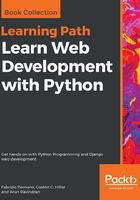
Built-in Data Types
Everything you do with a computer is managing data. Data comes in many different shapes and flavors. It's the music you listen to, the movies you stream, the PDFs you open. Even the source of the chapter you're reading at this very moment is just a file, which is data.
Data can be simple, an integer number to represent an age, or complex, like an order placed on a website. It can be about a single object or about a collection of them. Data can even be about data, that is, metadata. Data that describes the design of other data structures or data that describes application data or its context. In Python, objects are abstraction for data, and Python has an amazing variety of data structures that you can use to represent data, or combine them to create your own custom data.
In this chapter, we are going to cover the following:
- Python objects' structures
- Mutability and immutability
- Built-in data types: numbers, strings, sequences, collections, and mapping types
- The collections module
- Enumerations